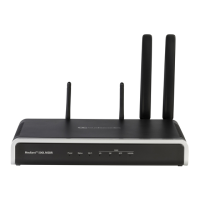User's Manual 450 Document #: LTRT-10466
Mediant 500L MSBR
• The conference-initiating INVITE sent by the device uses only the ConferenceID
as the Request-URI. The Conferencing server sets the Contact header of the 200
OK response to the actual unique identifier (Conference URI) to be used by the
participants. The Conference URI is included in the URI of the REFER with a
Replaces header sent by the device to the Conferencing server. The
Conferencing server then sends an INVITE with a Replaces header to the remote
participants. This mode is configured by setting the 3WayConferenceMode
parameter to 3.
When the device is used for Gateway and SBC applications, it can also support
conference calls initiated by third-party network entities (e.g., Skype for Business)
that use the same Conference server. To support these conference calls, you can
do one of the following:
♦ Configure the third-party network entity with a Conference ID that is different
from the Conference ID configured for the device.
♦ Configure the device with an Inbound Manipulation rule that is applied to
calls received from the third-party network entity so that the device considers
conference calls as regular calls and forwards them to the Conference
server without getting involved in the conferencing setup.
Local, On-board Conferencing: The conference is established on the device without
the need for an external Conferencing server. This feature includes local mixing and
transcoding of the 3-Way Call legs on the device, and even allowing multi-codec
conference calls. The number of simultaneous, on-board conferences can be limited
using the MaxInBoardConferenceCalls parameter. The device supports up to five
simultaneous, on-board, three-way conference calls. This mode is configured by
setting the 3WayConferenceMode parameter to 2.
Notes:
• Three-way conferencing using an external conference server is supported only by
FXS interfaces.
• Instead of using the flash-hook button to establish a three-way conference call,
you can dial a user-defined hook-flash code (e.g., "*1"), configured by the
HookFlashCode parameter.
• Three-way conferencing is applicable only to FXS and BRI interfaces.
• Three-way conferencing support for the BRI phones connected to the device
complies with ETS 300 185.
• The device supports high definition, three-way conferencing using wideband
codecs (e.g., G.722 and AMR-WB). This allows conference participants to
experience wideband voice quality. Call conferences can also include narrowband
and wideband participants.
The following example demonstrates three-way conferencing using the device's local, on-
board conferencing feature. In this example, telephone "A" connected to the device
establishes a three-way conference call with two remote IP phones, "B" and "C":
1. A establishes a regular call with B.
2. A places B on hold, by pressing the telephone's flash-hook button and the number "1"
key.
3. A hears a dial tone and then makes a call to C.
4. C answers the call.
5. A establishes a three-way conference call with B and C, by pressing the flash-hook
button and the number "3" key.
To configure local, on-board three-way conferencing:

